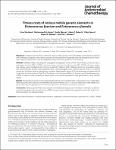Fitness costs of various mobile genetic elements in Enterococcus faecium and Enterococcus faecalis
Starikova, Irina
Al-Haroni, Mohammed
Werner, Guido
Roberts, Adam P.
Sørum, Vidar
Nielsen, Kaare M.
Johnsen, Pål J.
Objectives: To determine the fitness effects of various mobile genetic elements (MGEs) in Enterococcus faecium and Enterococcus faecalis when newly acquired. We also tested the hypothesis that the biological cost of vancomycin resistance plasmids could be mitigated during continuous growth in the laboratory. Methods: Different MGEs, including two conjugative transposons (CTns) of the Tn916 family (18 and 33 kb), a pathogenicity island (PAI) of 200 kb and vancomycin-resistance (vanA) plasmids (80–200 kb) of various origins and classes, were transferred into common ancestral E. faecium and E. faecalis strains by conjugation assays and experimentally evolved (vanA plasmids only). Transconjugants were characterized by PFGE, S1 nuclease assays and Southern blotting hybridization analyses. Single specific primer PCR was performed to determine the target sites for the insertion of the CTns. The fitness costs of various MGEs in E. faecium and E. faecalis were estimated in head-to-head competition experiments, and evolved populations were generated in serial transfer assays. Results: The biological cost of a newly acquired PAI and two CTns were both host- and insertion-locus-dependent. Newly acquired vanA plasmids may severely reduce host fitness (25%–27%), but these costs were rapidly mitigated after only 400 generations of continuous growth in the absence of antibiotic selection. Conclusions: Newly acquired MGEs may impose an immediate biological cost in E. faecium. However, as demonstrated for vanA plasmids, the initial costs of MGE carriage may be mitigated during growth and beneficial plasmid–host association can rapidly emerge.
Dateien zu dieser Publikation
Keine Lizenzangabe

